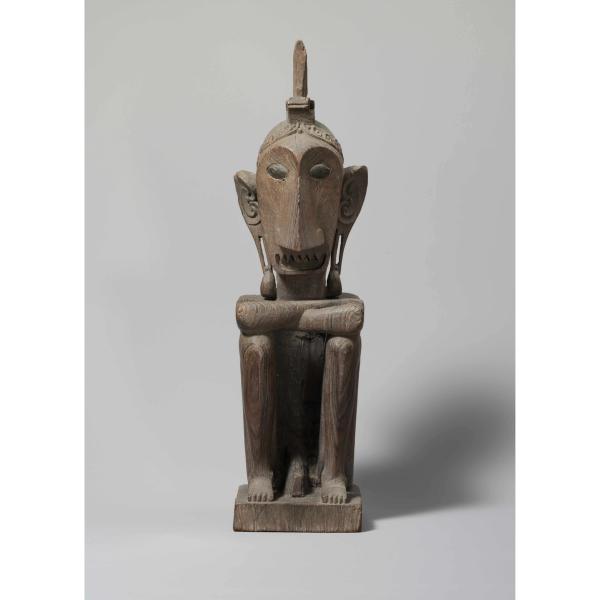Luli dera (ancestor figure)
Speaking the name of the ancestor who is represented by this figure is potentially dangerous, for it is the act of naming that calls the spiritual entity into the carving and brings them into the present. In Southwest Maluku, the act of storytelling is what brings reality into being – a reality that must be harnessed and controlled by whoever named it. Symbols, metaphors, thematic devices, and proverbs are used throughout many artforms in the Malukus, including woven textiles and creation narratives. Each symbol (rou) is given its own name (ktunu) and with that name comes an entire story that takes shape as a narrated reality in the present. The naming of this sculpture functions in the same way and it, too, would have been allocated a name. However, these carvings were largely destroyed or sold when much of Southwest Maluku converted to Christianity, and their names have not been spoken or passed down (rendering them inert and safe to view). Many sources refer to these sculptures as iene (or yene in Indonesian), which is a Letinese word that prohibits an action. In this case, it implies the name of this statue cannot be given. Letinese professor and linguist Aone van Engelenhoven suggests the name iene was possibly misunderstood by early collectors to be the name of this genre of carvings – a name that has been perpetuated in museum records. The term luli dera may be more applicable, for it refers more broadly to a male sacred entity, therefore avoiding any direct reference to the statue and the person it embodies.
Referencesvan Engelenhoven, Aone. Recorded conversation with the MET Digital and Curatorial teams. 21 November 2022.
Artwork Details
- Title: Luli dera (ancestor figure)
- Artist: Leti Islands artist
- Date: 19th–early 20th century
- Geography: Indonesia, Leti Islands, Maluku Tenggara
- Culture: Leti Islands
- Medium: Wood
- Dimensions: H. 12 3/4 in. × W. 4 in. × D. 3 1/4 in. (32.4 × 10.2 × 8.3 cm)
- Classification: Wood-Sculpture
- Credit Line: Gift of Fred and Rita Richman, 1987
- Object Number: 1987.453.5
- Curatorial Department: The Michael C. Rockefeller Wing
Audio

1724. Luli dera (ancestor figure), Leti Islands artist
Aone van Engelenhoven
AONE VAN ENGELENHOVEN: Storytelling is extremely important in Southwest Maluku, simply because we don’t really have a written history, so we only have a spoken... not really history, even, because we don’t have tense. So, in the moment that I tell the story, it happens. I use past tense because that's what you're supposed to do in English. But when you're an audience over there, then it's happening on the moment that you tell the story.
My name is Aone van Engelenhoven. I'm a university lecturer at Leiden University, and my research is on storytelling, specifically in East Indonesia. I am originally from Southwest Maluku.
KATERINA TEAIWA (NARRATOR): Statues like this one offered a way of remembering and communicating with specific ancestors, functioning like a telephone.
AONE VAN ENGELENHOVEN: They would put them up in the house and only the storyteller would go there. And he would take down a statue and then he would put it in front of him and then he would tell a story about it.
So nowadays we use a photograph of something. You have a photo of someone and then you can tell the story around it, my granddad would do that. But in the old days, we wouldn't have photos, so you have the statue.
KATERINA TEAIWA: Traditionally, groups of ancestor statues were kept in the rafters at the top of the house, where they were safe.
AONE VAN ENGELENHOVEN: You're not supposed to go up in the house. You grow up, that specifically in the old houses, that was not done. Even my grandmother in the Netherlands, she found it kind of uncomfortable if I would go play up there.
KATERINA TEAIWA: Today, Aone van Engelenhoven is continuing these storytelling traditions in his own family.
AONE VAN ENGELENHOVEN: My children, for example, I made sure that they were used to storytelling. Because I see it as intangible heritage.
More Artwork
Research Resources
The Met provides unparalleled resources for research and welcomes an international community of students and scholars. The Met's Open Access API is where creators and researchers can connect to the The Met collection. Open Access data and public domain images are available for unrestricted commercial and noncommercial use without permission or fee.
To request images under copyright and other restrictions, please use this Image Request form.
Feedback
We continue to research and examine historical and cultural context for objects in The Met collection. If you have comments or questions about this object record, please complete and submit this form. The Museum looks forward to receiving your comments.
